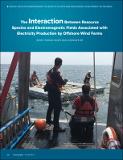Files in this item
The interaction between resource species and electromagnetic fields associated with electricity production by offshore wind farms
Item metadata
| dc.contributor.author | Hutchison, Zoë | |
| dc.contributor.author | Secor, David | |
| dc.contributor.author | Gill, Andrew | |
| dc.date.accessioned | 2021-02-12T15:30:12Z | |
| dc.date.available | 2021-02-12T15:30:12Z | |
| dc.date.issued | 2020-12 | |
| dc.identifier | 272309808 | |
| dc.identifier | f9b5f76a-3c49-4d5e-99e1-f6524d2d4f82 | |
| dc.identifier | 85099018977 | |
| dc.identifier.citation | Hutchison , Z , Secor , D & Gill , A 2020 , ' The interaction between resource species and electromagnetic fields associated with electricity production by offshore wind farms ' , Oceanography , vol. 33 , no. 4 , pp. 96-107 . https://doi.org/10.5670/oceanog.2020.409 | en |
| dc.identifier.issn | 1042-8275 | |
| dc.identifier.other | crossref: 10.5670/oceanog.2020.409 | |
| dc.identifier.other | ORCID: /0000-0003-1866-7877/work/87404766 | |
| dc.identifier.uri | https://hdl.handle.net/10023/21420 | |
| dc.description.abstract | As offshore wind energy production increases, the number of subsea cables will proliferate along with associated electromagnetic field (EMF) emissions. Understanding how EMF interactions (a potential pressure) affect resource species (receptor) requires an improved knowledge base to aid management decisions. Within the framework of a potential effect on a receptor, we review key aspects of assessing EMF exposure. From the vantage point of the receptor species, we consider how their perception of EMF varies through time as a consequence of species’ sensory biology, life history theory, and movement ecology. We review known effects of EMFs on species and consider EMF interactions with benthic, bentho-pelagic, and migratory species, focusing on functional roles of electro- and magneto-reception at different life stages. We must move our understanding from individual effects to population-level impacts. The present knowledge base has been drawn from a diverse range of laboratory and field approaches, which can be better integrated to address gaps and reach the desired knowledge base. Improving models of future scenarios depends on taking a more systematic and consistent approach to measuring and modeling alternating current and direct current EMFs and accounting for cable properties and local environmental characteristics. We make recommendations to help decipher receptor species’ responses. Acquiring such knowledge will enable us to translate EMFs, and their effects and encounter rates, into impact assessments for resource species to inform appropriate management. | |
| dc.format.extent | 743158 | |
| dc.language.iso | eng | |
| dc.relation.ispartof | Oceanography | en |
| dc.subject | T-NDAS | en |
| dc.title | The interaction between resource species and electromagnetic fields associated with electricity production by offshore wind farms | en |
| dc.type | Journal article | en |
| dc.contributor.institution | University of St Andrews. School of Biology | en |
| dc.identifier.doi | 10.5670/oceanog.2020.409 | |
| dc.description.status | Peer reviewed | en |
This item appears in the following Collection(s)
Items in the St Andrews Research Repository are protected by copyright, with all rights reserved, unless otherwise indicated.

